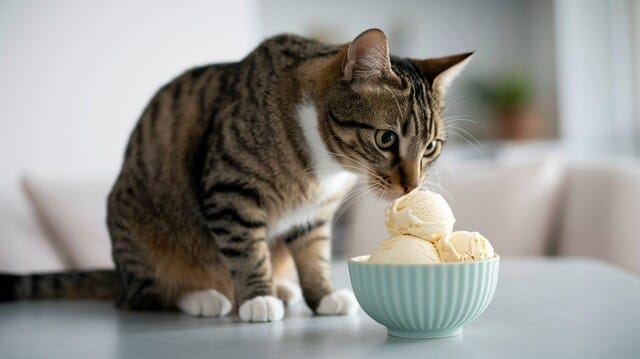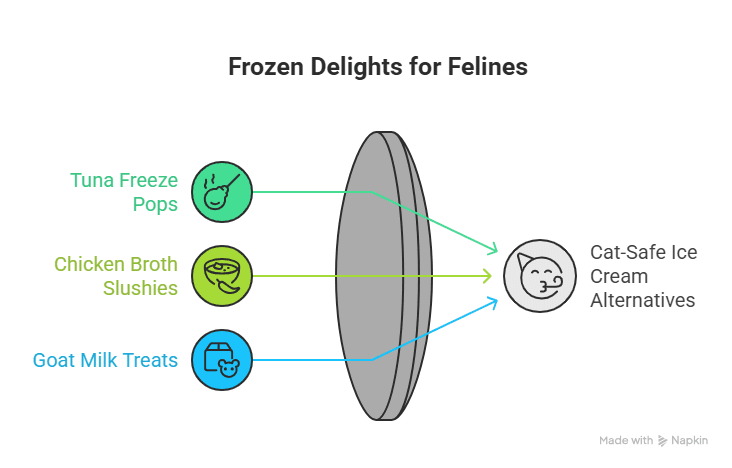
Introduction
You’re curled up on the couch with a bowl of ice cream, enjoying a quiet evening—and then it happens. Your cat hops up, gazes at you with those wide, pleading eyes, and maybe even tries to sneak a lick. It’s undeniably cute… but you pause and wonder:
Can cats eat ice cream?
You’re not alone in asking. This is one of the most commonly Googled cat-related food questions. And the answer isn’t as simple as yes or no.
In short: ice cream is not a safe treat for cats, even in small amounts. From lactose intolerance to toxic ingredients, there are several risks that come with sharing your frozen dessert with your feline friend.
In this comprehensive guide, we’ll walk you through:
– Why cats shouldn’t eat ice cream
– What happens if they do
– Dangerous ingredients to avoid
– Safer alternatives that your cat will love just as much
Let’s dig into the facts (and the flavors) to protect your cat’s health, without giving up those cute bonding moments.
What’s in Ice Cream That Might Be Harmful to Cats?
Ice cream is a treat created for humans. It’s creamy, sweet, and loaded with flavor, but many of its key ingredients can be harmful or even toxic to cats.
❌ Sugar
Cats can’t taste sweetness—literally. Unlike humans and dogs, cats lack the taste receptors for sugar. More importantly, sugar has no nutritional benefit for cats, and consuming it regularly may lead to:
– Obesity
– Diabetes
– Digestive upset
Even small amounts can stress a cat’s body, particularly their pancreas and digestive system.
❌ Dairy (Lactose)
This is the big one. Most adult cats are lactose intolerant, meaning they don’t have enough of the enzyme lactase to properly digest milk-based products. While kittens can digest their mother’s milk, the ability fades after weaning.
We’ll dive deeper into lactose intolerance in the next section.
❌ Artificial Sweeteners (Especially Xylitol)
While xylitol is more toxic to dogs than cats, it’s still a huge red flag in any pet diet. Even small traces of xylitol in ice cream can cause:
– Lethargy
– Vomiting
– Liver failure
Check labels—especially for “sugar-free” ice cream.
❌ Chocolate & Coffee Flavors
Both chocolate and caffeine (even in trace amounts) are toxic to cats. Chocolate contains theobromine, a stimulant that can lead to:
– Rapid heart rate
– Seizures
– Death in severe cases
Coffee ice cream, espresso chunks, and mocha swirl? Definitely off-limits.
❌ High Fat Content
Ice cream is rich in dairy fat and, while cats do need fats in their diet, the saturated fats in human treats like ice cream can overwhelm their digestive system, especially in large quantities.
Lactose Intolerance in Cats: What You Should Know
There’s a popular myth that cats love milk. While it’s true that cats are attracted to the creamy smell and texture, most adult cats lack the ability to properly digest lactose, the sugar found in milk and cream.
When a lactose-intolerant cat consumes ice cream, you may see symptoms like:
– Diarrhea
– Gas
– Bloating
– Vomiting
– Lethargy or discomfort
These symptoms can appear within hours and may last for a full day. While not usually fatal, it’s certainly unpleasant—and completely avoidable.
If your cat has tolerated dairy in the past, they may have a slightly better digestive capacity. But that still doesn’t make ice cream a safe or healthy choice.
Can Cats Digest Sugar and Cream?
Cats are obligate carnivores, which means their bodies are specifically designed to:
– Eat animal protein
– Process fat from meat sources
– Avoid carbohydrates and plant-based sugars
Unlike omnivores (like humans or dogs), cats:
– Don’t produce enzymes to process sugar effectively
– Lack of digestive mechanisms for dairy sugars
– Get no benefit from plant-based fats or sweeteners
Feeding your cat sugar-laden, dairy-rich foods like ice cream can cause long-term harm to organs like the pancreas and kidneys, even if it doesn’t cause an immediate reaction.
What About “Just a Lick” of Vanilla Ice Cream?
This is where many cat owners start to rationalize. “It’s just a little bit,” or “My cat seems fine after one lick.” And while it’s true that a tiny lick of plain vanilla ice cream probably won’t harm your cat immediately, it’s still not advisable.
Why Vanilla Is the Least Harmful (But Still Not Healthy)
Of all the flavors, vanilla:
– Doesn’t contain chocolate or caffeine
– Typically has fewer added mix-ins
– Is lower in risk compared to other flavors
But it still contains:
– Dairy
– Sugar
– Artificial flavorings
– Possible emulsifiers or thickeners
A lick here or there won’t poison your cat, but it can encourage bad habits and lead to:
– Begging for human food
– Upset stomachs
– Dangerous interest in more toxic foods
Dangers of Specific Ice Cream Flavors
Let’s break down some common and seasonal flavors, and why they should be avoided:
🍫 Chocolate
Contains theobromine and caffeine, both toxic to cats. Can cause:
– Tremors
– Heart arrhythmia
– Seizures
– Death
☕ Coffee / Espresso
High in caffeine, which can be deadly even in small doses.
🌿 Mint Chocolate Chip
Often contains artificial mint oils and chocolate chips—both can upset the stomach or worse.
🍓 Strawberry or Fruit Flavors
May contain xylitol, artificial coloring, or added acids that irritate a cat’s gut.
🍪 Cookies and Cream, Rocky Road, or Swirl Flavors
Loaded with sugar, chocolate, candy pieces, and possibly nuts, which are dangerous for cats.
Bottom line: if the flavor sounds indulgent for humans, it’s probably a disaster for your cat’s digestive system.
Are There Cat-Safe Ice Cream Alternatives?

Yes! If you’re looking to share a cold treat with your feline without risking their health, there are safe, fun alternatives you can try.
🍦 DIY Cat “Ice Cream” Recipes
1. Tuna Freeze Pops
– Blend tuna with a bit of water or cat-safe broth
– Pour into ice cube trays
– Freeze and serve one cube at a time
2. Chicken Broth Slushies
– Use unsalted, onion-free broth
– Mix with a little shredded cooked chicken
– Freeze into molds or silicone trays
3. Goat Milk Treats
– Unsweetened, pasteurized goat milk is easier for cats to digest
– Freeze in small batches with a touch of pumpkin purée or pureed salmon
🛍 Store-Bought Cat Ice Cream
There are brands that create frozen treats just for cats, like:
– Pet Winery’s Meow Melt
– PetSafe’s Frosty Treats
– Pawse Cat Ice Cream
Always check for:
– Zero dairy
– No added sugar or xylitol
– Vet-approved ingredients
What to Do If Your Cat Accidentally Eats Ice Cream
Don’t panic. A small lick of vanilla ice cream won’t usually cause major harm. But you should observe your cat closely over the next 24 hours.
Watch for These Symptoms:
– Vomiting
– Diarrhea
– Lethargy
– Rapid breathing
– Drooling or unusual behavior
If your cat ate a chocolate, coffee, or artificially sweetened flavor, contact your vet immediately. Bring the ice cream container with you or take a photo of the ingredients label.
FAQs
Can kittens have milk-based treats?
Kittens can digest lactose while nursing, but after weaning (around 8 weeks), their ability declines. It’s best to avoid milk-based treats altogether unless recommended by a vet.
Is lactose-free ice cream safe for cats?
While it removes the risk of lactose, it still contains sugar, artificial flavorings, and dairy fat—all of which are not ideal for cats. It’s still a no.
Why do cats seem to like ice cream?
They’re drawn to the smell and fat content, not the sugar. Some cats also enjoy the temperature or texture. But that doesn’t mean it’s good for them.
Also Read - Why Does My Cat Stare at Me While I Sleep? The Curious (and Slightly Creepy) Truth
Conclusion
So, can cats eat ice cream?
Technically, they can… but they absolutely shouldn’t.
Ice cream contains dairy, sugar, and often toxic ingredients that can make your cat:
– Sick in the short term
– Develop bad eating habits
– Suffer long-term health consequences
While a single lick of vanilla might not send your cat to the vet, it’s still not worth the risk. There are plenty of safer, tastier alternatives that are designed specifically for your furry friend.
If you’re looking to treat your cat, skip the freezer aisle and whip up a DIY frozen snack instead. Your cat’s belly—and your vet bill—will thank you.




